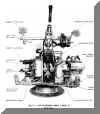TECHNICAL |
Weapon Systems
|
|
|
[ Technical ] [This section was contributed by Jim Gray who served
|
 |
 |
 |
However, when used on boats the ranges were a lot closer. The basic gun crew was 3 men. The pointer, trainer, and loader. The pointer sat on the left side of the gun and controlled the evaluation, and fired the weapon. The trainer controlled the traverse of the gun mount. These movements required the pointer and trainer to both aim and track the target, so they were indeed a team. The Loader stood behind the pointer and dropped 4 round clips into the automatic loader which could handle 2 clips at a time, one on top of another. The pointer, trainer, and loader were all linked with communication by sound powered phones with the conn of the PTF for firing orders. Other members of the gun crew were the shell passers who would get the 4 round clips from the ready service box and pass them to the loader. The ready service boxes were port and stb. of the weapon and held 256 rounds. The PTF on the average carried 832 rounds on board. Boat captains would dictate the ammunition amount, and that was dependant on mission requirements, weight and space. This included all weapons aboard the PTF.
It had two firing modes, trigger fire, which the Gunner looked through the sites and pulled the trigger, and drop fire, which the mortar is in a fixed position and the mortar projectile goes off when it reaches the base of the barrel and the firing pin extended. (in trigger fire mode the firing pin is retracted and cocked and released by pulling the trigger). The mortar fired a variety of rounds, including HE, illumination, and white phosphorous (wp) with a variety of fuses as well which were point detonating or timed. The range of the 81mm varied but 4,000 yds was average, and with trigger fire (aimed) was always direct line of site. The mortar crew usually consisted of 2 men. The loader whose duty was to take the propellant increments off for the appropriate range, and set the fuse, then load the round into the muzzle when he received the command by the gunner. The mortar captain/gunner would train elevate and aim and fire in trigger fire mode. He would give the commands to the loader of what fuse setting, how many increments and when to load. The gunner would normally be linked to the conn by sound powered phones. The ready service box for the 81mm ammo carried 24 rounds, and a PTF would on an average carry 72 rounds of various type ammo. Why the 50 .cal mg m2 was mounted on top of the 81mm mortar will be explained in more detail in another chapter.
The 20mm was magazine fed. The magazine was a spring loaded drum type that held 60 lbs. which weighed 61 lbs loaded. These magazines were pre-loaded and care had to be used loading them or the rounds would topple over the feed guides and would cause jamming. Gun crews were usually a gunner and loader. The gunner aimed and fired the weapon when commanded from the conn by sound powered phone. The loader replaced empty magazines with full, and when needed replaced the barrel of the 20mm with a new one stored in tubes on the side of the super structure. A interesting and humorous problem developed when first training the CSS gunners on the 20mm. The shorter stature South Vietnamese had trouble reaching the shoulder cradles and seeing the aim site. The loader had to really use a lot of muscle to get the magazine up to the top of the weapon. The problem was the 20mm cannon was too tall for the South Vietnamese. The solution was that elevated platforms were built around the weapon. There were two ready service boxes for each 20mm (two port and two stb.). Each box held 8 magazines, A PTF carried on the average 1,920 rds of ammo for the 20mm cannon.
The PTFs also carried small arms for its crew that included M-16's, M-79's, 66mm LAWW's, pistols, and other weapons needed for a mission north including foreign weapons, to even a flame thrower, if needed.
PTF's had other weapons, again with shore bombardment the main emphasis. One of the earliest weapons of this type was the 57mm recoilless rifle carried by the SCT teams. This was a shoulder fired weapon with a range of 4000 yds. It was originally designed as a anti-tank weapon for the Army. But what was clear was this weapon had a back blast and the blast had to be taken in careful consideration when firing the weapon off of a boat. Later a 106mm recoilless rifle was tested on a PTF in Da Nang for weeks and would give the PTF a greater stand-off range. Unfortunately, in the test firings the 106 mm caused considerable shock damage to various components of the PTF, so the idea was dropped. The most successful field modification to the PTFs was done by MST in 1971 when four Russian made 122mm rocket launchers were installed on the PTFs, two tubes port side two tubes stb. side. This weapon set-up was successful to a degree and gave the PTFs a stand-off range of 11,000 yds, and could be reloaded in 15 minutes.
In the United States at Boat Support Unit One, ( later called Coastal River Squadron One) PTF-13 was the training platform for deploying U.S. Crews to MST. PTF-13 was also a test platform for weapons systems as well. The red-eye anti aircraft shoulder fired missile was successfully tested on the PTF in 1966. Later PTF-13 was again used as test platform for a experimental stabilization system for the 40mm cannon. Also a 20mm Hispano Suiza cannon with a higher rate of fire was evaluated.
![]()